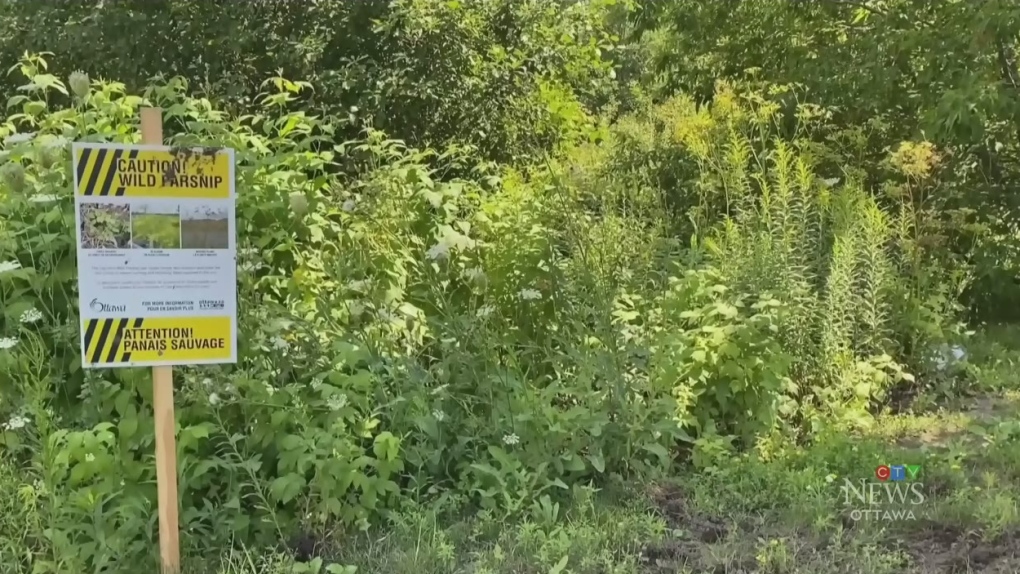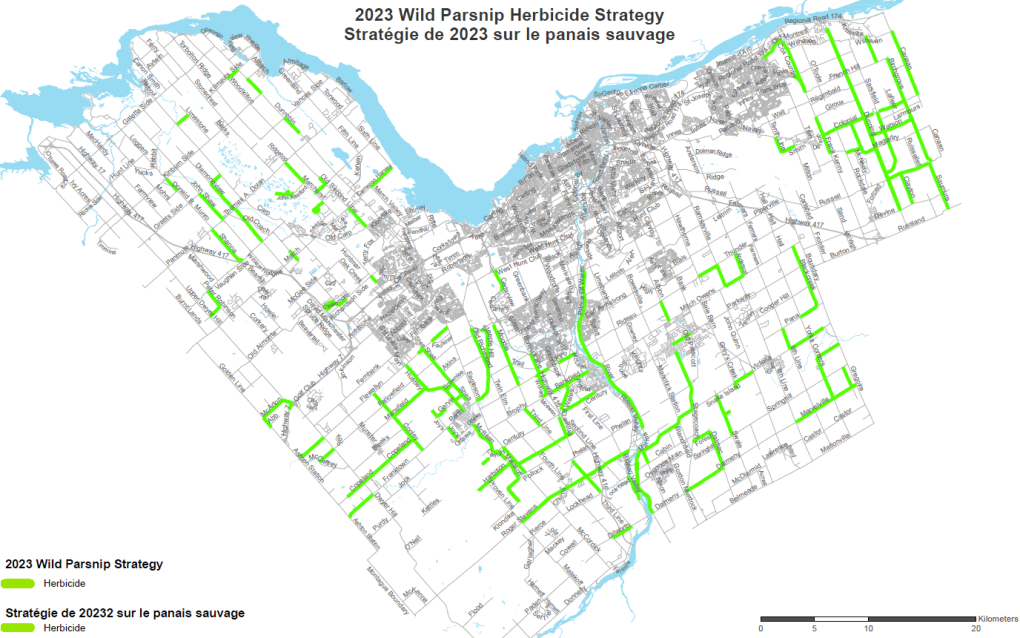Ottawa to begin spraying and mowing wild parsnip in suburban and rural areas

The city of Ottawa will begin spraying and mowing roadsides, pathways and parks this week to deal with wild parsnip, the invasive plant that can cause skin and eye irritation and make the skin prone to burning and blistering.
Approximately 650 lane kilometres of roadsides and pathways and over 200 park locations in suburban and rural areas will be treated with herbicides and mowed over the next few weeks and months.
"The goal is to reduce the growth of wild parsnip in highly infested areas while ensuring that environmentally sensitive areas and public safety are not adversely impacted," Allison Wilson, manager of technical operations with Public Works, said in a memo to Council.
In addition to the application of herbicides in highly infected areas, staff will continue, "mowing operations, adjusting frequency and timing to best coincide with herbicide applications."
Wilson says a "Notice of Herbicide Use" advertisement will appear in local newspapers one week prior to the start of spraying in public locations. Signs will also be posted every 100 metres along pathways and parks.
The Wild Parsnip Program will begin on Monday, with spraying in city parks to begin on June 6, weather permitting. Roadside grass cutting will also begin in early June.
The city will spend $298,000 to deal with wild parsnip this spring and summer.
Wild parsnip has been identified as a noxious weed in Ontario since Jan. 1, 2015.
Rural property owners can ask the city not to spray the areas adjacent to their property.
"Should a resident opt-out of the program, it will become their responsibility to manage any wild parsnip infestation adjacent to their property, as required by the Weed Control Act, 1990," Wilson says.
 The city of Ottawa released a map outlining where herbicides will be sprayed along roadsides/pathways and parkland to deal with wild parsnip. (City of Ottawa/memo)
The city of Ottawa released a map outlining where herbicides will be sprayed along roadsides/pathways and parkland to deal with wild parsnip. (City of Ottawa/memo)
Identifying wild parsnip
Wild parsnip is a highly branched plant, with hollow green stems, according to the city of Ottawa's website.
"It has two growth stages: non-flowering leafy rosettes at ground level and 0.5 to 1.5 metre-tall flowering plants."
The city outlines the stages of growth for wild parsnip on its website:
- Early growth: In the first year of growth, low-growing non-flowering rosettes of leaves form with a cluster of spindly, compound leaves that resemble celery leaves.
- In bloom: When wild parsnip is in bloom, usually in the second and third-year plants have tall, branched yellow flowering stalks that usually bloom in early June to late July.
- Mature plant: Starting in August the blooming plant will begin to turn brown and the leaves and stems will begin to dry up. This means that the toxic sap from the plant will also begin to dry up, and contact with the plant is less likely to cause a reaction.
How to avoid the plant
The city of Ottawa offers the following tips to avoid wild parsnip on pathways and in parks:
- It is recommended that the public stay on the groomed areas of parks, roadsides and pathways where there are less instances of wild parsnip.
- When working around wild parsnip or when walking through dense vegetation, wear goggles, gloves, long pants and long-sleeved shirts.
- Children should be reminded not to pick wild flowers
- If you are exposed to the plant sap, wash the contaminated area(s) thoroughly as soon as possible, and seek medical attention if skin irritation occurs
CTVNews.ca Top Stories

Prince William says wife Kate is 'doing well'
Prince William said on Friday his wife Kate was 'doing well' in a rare public comment about the Princess of Wales as she undergoes preventative chemotherapy for cancer.
BREAKING Canadian Blood Services apologizes to LGBTQ2S+ community for discriminatory blood donation policy
Canadian Blood Services issued an apology on Friday to the LGBTQ2S+ community for what it now admits was a harmful and discriminatory blood donation policy that prevented sexually active men who have sex with men and some trans people from donating blood and plasma.
BREAKING Toronto mayor hints that WNBA team is coming to the city, marking the first franchise in Canada
Toronto Mayor Olivia Chow says that she is hopeful an announcement could be made soon amid multiple reports that a WNBA team is coming to Toronto in 2026.
Magnitude 4.2 earthquake reported off Vancouver Island's west coast
A 4.2-magnitude earthquake was recorded west of Vancouver Island early Friday morning.
Ontario coroner to investigate death of man who suffered cardiac arrest while waiting in ER
A provincial coroner will be investigating the death of 68-year-old David Lippert, who suffered a cardiac arrest while waiting in a crowded emergency room in Kitchener, Ont.
'Irate male' assaulted Newfoundland officers with block of cheese, police say
Police in Newfoundland say patrol officers were assaulted Thursday by a "very irate male" wielding a block of cheese.
Average hourly wage in Canada now $34.95: StatCan
Average hourly wages among Canadian employees rose to $34.95 on a year-over-year basis in April, a 4.7 per cent increase, according to a Statistics Canada report released Friday morning.
This iconic Canadian song is turning 50
Andy Kim's 'Rock Me Gently' is marking a major milestone, as it celebrates its 50th anniversary.
From outer space? Sask. farmers baffled after discovering strange wreckage in field
A family of fifth generation farmers from Ituna, Sask. are trying to find answers after discovering several strange objects lying on their land.

































